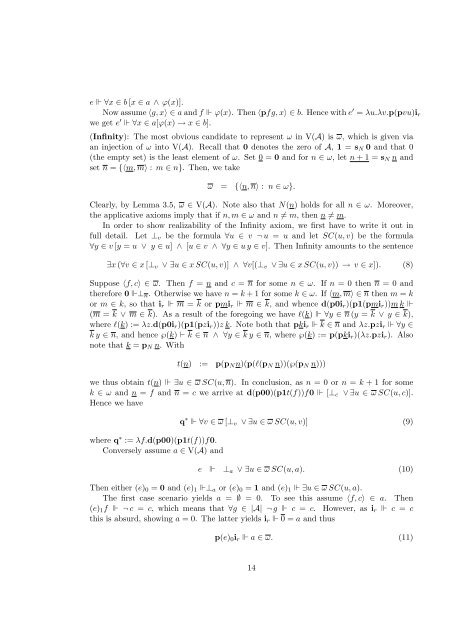Realizability for Constructive Zermelo-Fraenkel Set Theory
Realizability for Constructive Zermelo-Fraenkel Set Theory
Realizability for Constructive Zermelo-Fraenkel Set Theory
You also want an ePaper? Increase the reach of your titles
YUMPU automatically turns print PDFs into web optimized ePapers that Google loves.
e ⊩ ∀x ∈ b [x ∈ a ∧ ϕ(x)].Now assume 〈g, x〉 ∈ a and f ⊩ ϕ(x). Then 〈pfg, x〉 ∈ b. Hence with e ′ = λu.λv.p(pvu)i rwe get e ′ ⊩ ∀x ∈ a[ϕ(x) → x ∈ b].(Infinity): The most obvious candidate to represent ω in V(A) is ω, which is given viaan injection of ω into V(A). Recall that 0 denotes the zero of A, 1 = s N 0 and that 0(the empty set) is the least element of ω. <strong>Set</strong> 0 = 0 and <strong>for</strong> n ∈ ω, let n + 1 = s N n andset n = {〈m, m〉 : m ∈ n}. Then, we takeω = {〈n, n〉 : n ∈ ω}.Clearly, by Lemma 3.5, ω ∈ V(A). Note also that N(n) holds <strong>for</strong> all n ∈ ω. Moreover,the applicative axioms imply that if n, m ∈ ω and n ≠ m, then n ≠ m.In order to show realizability of the Infinity axiom, we first have to write it out infull detail. Let ⊥ v be the <strong>for</strong>mula ∀u ∈ v ¬ u = u and let SC(u, v) be the <strong>for</strong>mula∀y ∈ v [y = u ∨ y ∈ u] ∧ [u ∈ v ∧ ∀y ∈ u y ∈ v]. Then Infinity amounts to the sentence∃x (∀v ∈ x [⊥ v ∨ ∃u ∈ x SC(u, v)] ∧ ∀v[(⊥ v ∨ ∃u ∈ x SC(u, v)) → v ∈ x]). (8)Suppose 〈f, c〉 ∈ ω. Then f = n and c = n <strong>for</strong> some n ∈ ω. If n = 0 then n = 0 andthere<strong>for</strong>e 0 ⊩⊥ n . Otherwise we have n = k + 1 <strong>for</strong> some k ∈ ω. If 〈m, m〉 ∈ n then m = kor m ∈ k, so that i r ⊩ m = k or pmi r ⊩ m ∈ k, and whence d(p0i r )(p1(pmi r ))m k ⊩(m = k ∨ m ∈ k). As a result of the <strong>for</strong>egoing we have l(k) ⊩ ∀y ∈ n (y = k ∨ y ∈ k),where l(k) := λz.d(p0i r )(p1(pzi r ))z k. Note both that pki r ⊩ k ∈ n and λz.pzi r ⊩ ∀y ∈k y ∈ n, and hence ℘(k) ⊢ k ∈ n ∧ ∀y ∈ k y ∈ n, where ℘(k) := p(pki r )(λz.pzi r ). Alsonote that k = p N n. Witht(n) := p(p N n)(p(l(p N n))(℘(p N n)))we thus obtain t(n) ⊩ ∃u ∈ ω SC(u, n). In conclusion, as n = 0 or n = k + 1 <strong>for</strong> somek ∈ ω and n = f and n = c we arrive at d(p00)(p1t(f))f0 ⊩ [⊥ c ∨ ∃u ∈ ω SC(u, c)].Hence we havewhere q ∗ := λf.d(p00)(p1t(f))f0.Conversely assume a ∈ V(A) andq ∗ ⊩ ∀v ∈ ω [⊥ v ∨ ∃u ∈ ω SC(u, v)] (9)e ⊩ ⊥ a ∨ ∃u ∈ ω SC(u, a). (10)Then either (e) 0 = 0 and (e) 1 ⊩⊥ a or (e) 0 = 1 and (e) 1 ⊩ ∃u ∈ ω SC(u, a).The first case scenario yields a = ∅ = 0. To see this assume 〈f, c〉 ∈ a. Then(e) 1 f ⊩ ¬ c = c, which means that ∀g ∈ |A| ¬ g ⊩ c = c. However, as i r ⊩ c = cthis is absurd, showing a = 0. The latter yields i r ⊩ 0 = a and thusp(e) 0 i r ⊩ a ∈ ω. (11)14
















